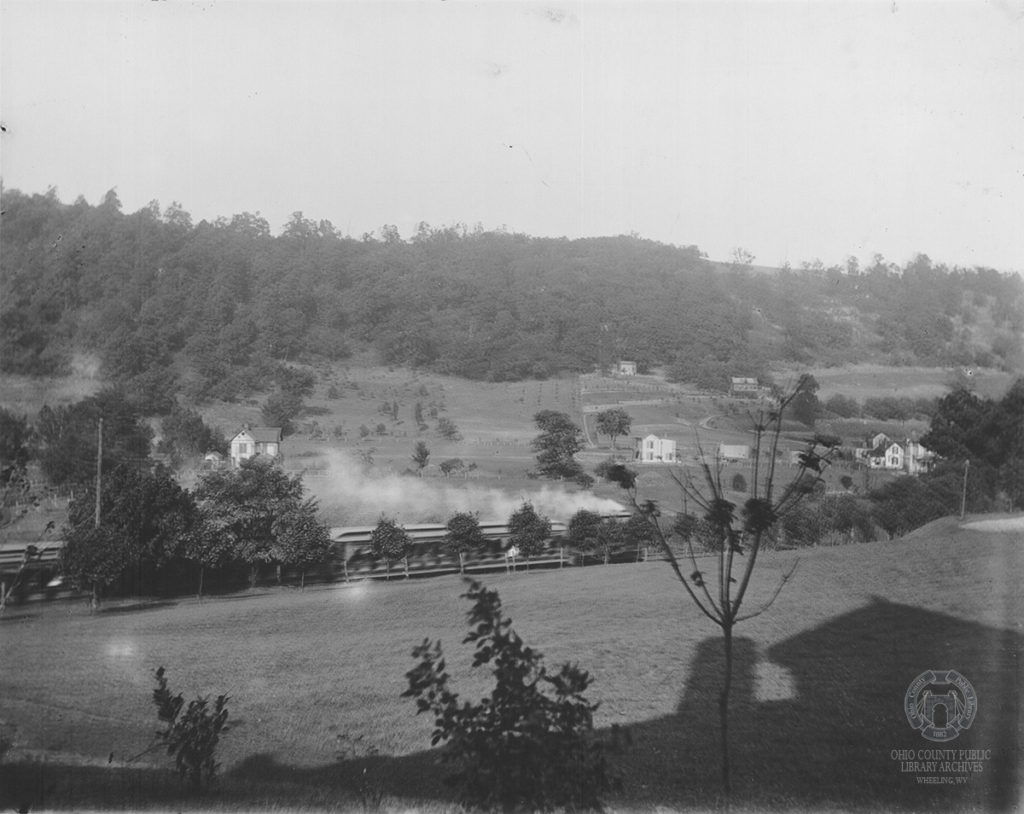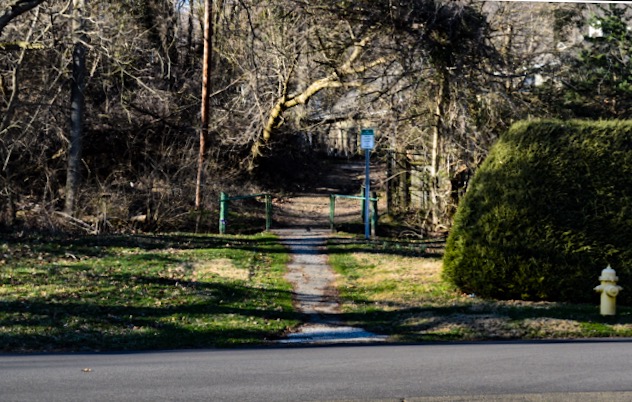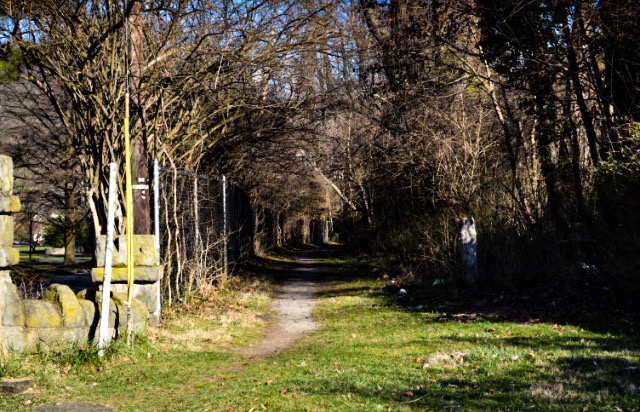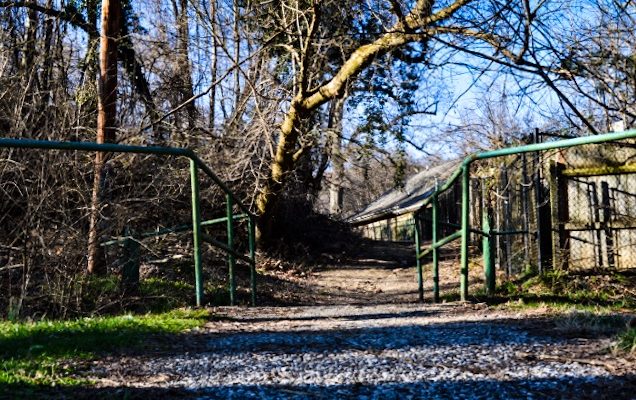It was a shortcut for kids from both sides of the “The Path,” and it transported us to different worlds depending upon which side you lived.
If you were raised along the Walnuts, Poplars, Maples, and up on the streets toward the hilltop, the path delivered you to the commercial side of Woodsdale, where Ye Olde Alpha, the Minute Market, Frank’s Hairquarters, and the Rose Bowl offered action, but if those reared in the Edgington Lane area navigated the former trolley trail, they found themselves near huge houses, churches, and schools, and also a hill-free path to Burger Chef and Rax along Pine Avenue.

These days there is still evidence the path is traversed regularly as it was when the Edgington Lane Playground was new, before the Checkboard Bar burned to the ground, and when the Colonel sold root beer floats at the confectionary. In the 1970s, the trail, wedged in between two circles of mansions inside Echo Point Circle and Kenwood Place, was consistently surfaced with cinders and groomed by city employees, but these days half of the path is overtaken by overgrowth, fencing divides walkers from the north and south, and the surface is more muddy than maintained.
The one constant though is a debate about its moniker because it seems in the 1960s it was known as “Lovers’ Lane,” in the 1970s it was referred to as “The Path,” but in the 1980s and after it has been known as “The Pig Path.”
“To this day, I have no idea why it was ever called that,” said Jule Carenbauer, a 56-year-old who grew up on Edgington Lane. “I heard both when I was younger but to me it was always ‘The Path.’”
There were some folks who referred to the hidden-away track as “Lovers’ Lane” because when visitors were within the thin clearing, they were out-of-sight from most others. The huge houses inside Echo Point Circle are elevated nearly 50 feet up a hillside, and the homes inside Kenwood Place are behind a chain-link fence and a thick cover of trees and brush. During the 1970s, the fencing was not yet erected, allowing children to cut through yards to reach their destinations.
The Woodsdale neighborhood now is a national historic district, designated as such in 1997, and it includes about 970 buildings and homes. The area initially was farmland but was developed as a residential area between 1888 and 1945, according to records archived by the Wheeling National Heritage Area Corp.

Ohio County Sheriff Tom Howard said he was told by a veteran police officer several years ago that the throughway became known as “The Pig Path” because of the farming history of the area.
“For a lot of years I only knew it as ‘The Path,’ but then I heard some people referring to it as ‘The Pig Path,’ so I asked a couple of the old-timers on the force, and one of them explained something to me,” said Howard, who served on the Wheeling Police Department for more than two decades before he was elected as sheriff in November. “He said that a long time before Woodsdale became what it is today, the whole area was a farm, and they used that path to herd the pigs to market.”
During his career with the Wheeling Police Department, Howard was not dispatched to the path very often because of disturbances caused by kids. He did recall an overdose incident that took place along the walkway nearly two years ago.
“I know the kids used to go in the middle of it a bunch of years ago and have their fights, but that was pretty much it,” he continued. “The teenagers that went there usually kept their voices down so the neighbors wouldn’t call us at the station. They were pretty smart about that.”
“But yeah, there was the overdose death that we had to go to, and that was the worst. That scared me because I didn’t know if that was the new place to go for that sort of activity,” he said. “Thankfully, that’s the only one I know about and I just pray that it’s the only one ever.”
Kurt Krieger now lives in Charleston, W.Va., but he was raised along Edgwood Street on the west side of the path and biked it often to reach the rows of penny candy and the coolers packed with Coca Cola.
“We biked to the Minute Market, and yes, usually to buy candy. It wasn’t until I was an adult that I heard it called the pig path. It was always just called the path and everyone knew what that was,” he said. “The path was more fun, and it was a shortcut. It was gravel and fun to ride on with a bike. And I recall at the (east) end it sloped downhill over the small stream, and you shot out into Elm Street.”
Michelle Gantzer Kratzer biked the path, too, to visit family and find friends on the other side. A Pittsburgh resident today, she recalled a touch of fear when navigating the trail.
“My cousin Becky and I would ride through the path all the time on our bikes to visit my Aunt Teresa and Aunt Helen, and so we could ride around Woodsdale elementary playground,” she said. “It was always so scary as a child. My heart would always race as we rode or ran from start to end on the path. And I was always completely in awe of the beautiful homes along the path which made me a little perplexed as to why the pig path was so scary.”

Carenbauer has a clue why that may have been.
“When I was a kid, we used it as a shortcut, yes, but it was also to go in there and, as a kid, just hideaway if that’s what you wanted to do. It was sort of an escape from being in the middle of the neighborhood where everyone could see you at the playground or in front of the Minute Market,” he explained. “There were the woods and the creek. It was like a park without the stuff, and it was a ‘right of passage’ thing for the kids in that neighborhood.
“But when I reached 16 or 17, well, that’s when we started going to the path at night,” Carenbauer said. “There were kids there drinking beer and smoking whatever, and no one really bothered each other. In fact, that’s where I tried smoking the one and only time I did. I was in the middle of the path one night with a couple of girls, and they had some cigarettes, but they weren’t inhaling, but when it came to my turn, I inhaled, and that was the end of that, I tell ya. I’m sure everyone along that path that night heard me choking. It was pretty bad, but I guess that’s what I needed so I wouldn’t smoke during my lifetime.”
But he continued to visit the path because, during the 1970s and early 1980s, it was the popular place to be for those Carenbauer’s age and older.
“I can remember some summer nights when there were people all over the place, and not just along the main path,” he said. “People were having parties along the creek because there was a smaller path down to an area, and there were also paths to other hideaways because, during the summer, it was always grown over to the extent to where you really couldn’t see anyone.
“You would hear the talk, and the clang of the bottles, and yeah, you would smell some things,” Carenbauer said with a snicker. “It was the place where we could just get away, like an escape, really. If you wanted you and your friends to be left alone, you went to the path because you could be on your own.”
(Photos by Steve Novotney)
[satellite gallery=50]




